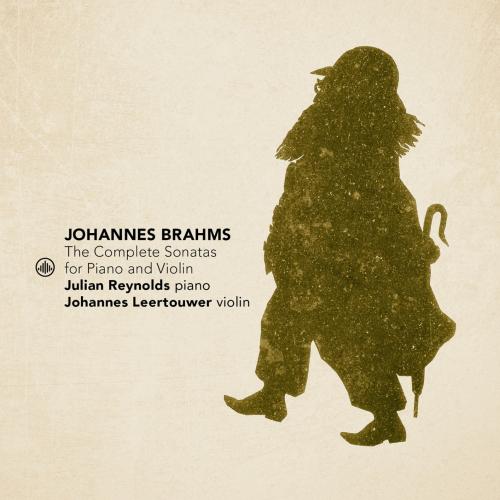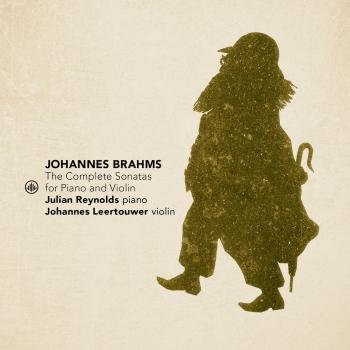
Brahms: The Complete Sonatas for Piano and Violin Johannes Leertouwer & Julian Reynolds
Album Info
Album Veröffentlichung:
2023
HRA-Veröffentlichung:
04.08.2023
Label: Challenge Classics
Genre: Classical
Subgenre: Instrumental
Interpret: Johannes Leertouwer & Julian Reynolds
Komponist: Johannes Brahms (1833-1897)
Das Album enthält Albumcover Booklet (PDF)
- Johannes Brahms (1833 - 1897): Violin Sonata No. 1, Op. 78 in G Major:
- 1 Brahms: Violin Sonata No. 1, Op. 78 in G Major: I. Allegro ma non troppo 10:56
- 2 Brahms: Violin Sonata No. 1, Op. 78 in G Major: II. Adagio 07:10
- 3 Brahms: Violin Sonata No. 1, Op. 78 in G Major: III. Allegro molto moderato 08:34
- Violin Sonata No. 2, Op. 100 in A Major:
- 4 Brahms: Violin Sonata No. 2, Op. 100 in A Major: I. Allegro amabile 08:59
- 5 Brahms: Violin Sonata No. 2, Op. 100 in A Major: II. Andante tranquillo - Vivace- Andante- Vivace di più- Andante - Vivace 06:53
- 6 Brahms: Violin Sonata No. 2, Op. 100 in A Major: III. Allegretto grazioso (quasi andante) 05:53
- Violin Sonata No. 3, Op. 108 in D Minor:
- 7 Brahms: Violin Sonata No. 3, Op. 108 in D Minor: I. Allegro 08:48
- 8 Brahms: Violin Sonata No. 3, Op. 108 in D Minor: II. Adagio 04:09
- 9 Brahms: Violin Sonata No. 3, Op. 108 in D Minor: III. Un poco presto e con sentimento 03:09
- 10 Brahms: Violin Sonata No. 3, Op. 108 in D Minor: IV. Presto agitato 06:25
Info zu Brahms: The Complete Sonatas for Piano and Violin
Wir haben diese Aufnahme im Januar 2023 gemacht, eine Woche bevor ich meine Dissertation über die historische Aufführungspraxis von Brahms’ Orchestermusik an der Universität Leiden verteidigte und meinen Doktortitel erhielt. Die Forschungsarbeit bot mir die Gelegenheit, meine Vorstellungen über den zeitgenössischen Aufführungsstil, insbesondere von Repertoire des 18. und 19. Jahrhunderts, neu zu untersuchen. Im Laufe des vierjährigen Projekts hatte ich die Brahms-Sinfonien und -Konzerte als Dirigent geprobt, aufgeführt und aufgenommen. Nach so viel Lesen, Schreiben und Dirigieren sehnte ich mich nach der Erfahrung, das, was ich als Geiger entdeckt hatte, anzuwenden, um herauszufinden, wie es meine Herangehensweise an Brahms’ Kammermusik verändert hatte. Ich rief Julian Reynolds an und fragte ihn, ob er bereit wäre, mit meinen Erkenntnissen zu experimentieren. Wir hatten die Violinsonaten von Brahms vor vielen Jahren zusammen mit Josef Suk in Wien und Prag studiert. Im Atelier der Andriessen Klaviere in Haarlem fanden wir einen wunderschönen Blüthner Flügel von 1857.
Unsere Aufnahme steht für unseren Wunsch, die Freiheit zu finden, die Ausdrucksmittel des 19. Jahrhunderts – Flexibilität von Rhythmus und Tempo, ausdrucksstarkes Legato, Portamento und Vibrato – anzuwenden, die im Laufe des letzten Jahrhunderts weitgehend in Vergessenheit geraten oder vielleicht sogar verworfen worden sind. Diese Instrumente können nicht einfach entstaubt und neu implementiert werden. Wie ich in meiner Dissertation dargelegt habe, muss man sie neu erfinden, um mit ihnen zu arbeiten. Das Portamento zum Beispiel war im 19. Jahrhundert ein heiß diskutiertes Thema. Es gibt kein einziges Modell oder Beispiel dafür, wie man es heute anwendet. Das Gleiche kann man über das Vibrato sagen. Was wir mit Sicherheit sagen können, ist, dass in den Violinmethoden von Louis Spohr und später Joseph Joachim und Andreas Moser das Portamento als erstes und wichtigstes Ausdrucksmittel für Streicher genannt und das Vibrato als Verzierung bezeichnet wurde. Was die Flexibilität des Tempos anbelangt, so können wir sicher sein, dass der Tempobegriff des 19. Jahrhunderts flexibler war und dass Tempomodifikationen viel häufiger vorkamen als in moderneren Zeiten. Wir wissen, dass Brahms eine besonders freie und flexible Art der Aufführung seiner eigenen Musik hatte. Er selbst weigerte sich bekanntlich, Metronomangaben zu machen, da er keine sinnvolle Beziehung zwischen seinem Fleisch und Blut und einem solchen mechanischen Instrument finden konnte – ein Gefühl, das er vielleicht von Beethoven geerbt hatte. Er schrieb auch, dass jeder »vernünftige Musiker« jede Woche ein anderes Tempo nehmen würde.
Johannes Leertouwer, Violine
Julian Reynolds, Klavier
Johannes Leertouwer
is chief conductor and artistic director of the recently formed Nieuwe Philharmonie Utrecht.
In September of 2009, he conducted this orchestra in an exciting and much praised debut which featured a program of Stravinsky and Ravel and he will continue to lead the NPU in a series of concerts and special projects in the coming years. The orchestra performs on period instruments as well as repertoire of the nineteenth- and early twentieth century. It also features an extensive educational program, and therefore clearly carries the signature of its chief conductor.
Johannes Leertouwer studied conducting with David Porcelijn and the legendary Finnish professor Jorma Panula, He has worked as guest conductor with various orchestras, such as the Noord Nederlands Orkest, choir and orchestra of the Netherlands Bach Society. He has also worked with orchestras in Belgium, France, Japan and Mexico. From 1989 to 2006 he was artistic director and conductor of the Netherlands Youth String Orchestra, and also conducted various projects at European conservatories in Paris, Antwerp, Leipzig and Amsterdam.
After studying violin with Bouw Lemkes in Amsterdam and Josef Suk in Vienna and Prague, Johannes Leertouwer decided to specialize in historical performance practice. He worked as concertmaster and soloist with a number of international period instrument ensembles and orchestras, such as Anima Eterna, and the orchestra and choir of the Nederlandse Bach Vereniging.
Together with his duo partners Menno van Delft (harpsichord) and Julian Reynolds (fortepiano) he has made a series of CD recordings on the Globe label which feature works by Bach, Mozart, Beethoven, Schubert and Schumann. With the Schönbrunn Ensemble, of which he has been a member since its founding in 1987, he performs both in the Netherlands and abroad. He has also made a series of CD’s with this ensemble, the most recent of which contains works of Graf, Reicha and Ries. In 2006, the Mozart year, Johannes Leertouwer was the soloist and conductor in a highly acclaimed CD-recording of the complete works for violin and orchestra by Mozart (Challenge).
Since 1989 he has been a professor of violin at the Conservatory of Amsterdam. He gives masterclasses and guest teaches in many countries both within and outside of Europe. As a conductor he is able to draw not only on his years of experience with the ensembles and orchestras that are leading the way in historical performance practice, but also on his experience in Romantic and twentieth-century orchestral practice. Already during his violin studies he worked with world famous conductors such as Haitink, Abbado, Bernstein and Harnoncourt.
Johannes Leertouwer is a conductor with a broad repertoire and an exceptionally acute consciousness of style. From his specialization, the Viennese Classics, he has built up his repertoire without limiting himself to any particular style period. Among the works he has conducted are Sibelius’ Symphony No.5, Berlioz’s Symphonie Fantastique and Bach’s St. Matthew Passion; he has also conducted world premieres of works by Patricio Wang, Maurice Horsthuis, Frank Agsteribbe and others.
Booklet für Brahms: The Complete Sonatas for Piano and Violin










